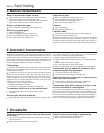
failure of components such as fuses or spark
plugs may only be pointers to some
underlying fault.
The pages which follow provide an easy-
reference guide to the more common
problems which may occur during the
operation of the vehicle. These problems and
their possible causes are grouped under
headings denoting various components or
systems, such as Engine, Cooling system,
etc. The Chapter and/or Section which deals
with the problem is also shown in brackets.
Whatever the fault, certain basic principles
apply. These are as follows:
Verify the fault. This is simply a matter of
being sure that you know what the symptoms
are before starting work. This is particularly
important if you are investigating a fault for
someone else, who may not have described it
very accurately.
Don’t overlook the obvious. For example, if
the vehicle won’t start, is there petrol in the
tank? (Don’t take anyone else’s word on this
particular point, and don’t trust the fuel gauge
either!) If an electrical fault is indicated, look
for loose or broken wires before digging out
the test gear.
Cure the disease, not the symptom.
Substituting a flat battery with a fully-charged
one will get you off the hard shoulder, but if
the underlying cause is not attended to, the
new battery will go the same way. Similarly,
changing oil-fouled spark plugs for a new set
will get you moving again, but remember that
the reason for the fouling (if it wasn’t simply an
incorrect grade of plug) will have to be
established and corrected.
Don’t take anything for granted. Particularly,
don’t forget that a “new” component may
itself be defective (especially if it’s been
rattling around in the boot for months), and
don’t leave components out of a fault
diagnosis sequence just because they are
new or recently-fitted. When you do finally
diagnose a difficult fault, you’ll probably
realise that all the evidence was there from
the start.
Fault finding REF•13
REF
1 Engine
Engine fails to rotate when attempting to start
ⅥⅥ Battery terminal connections loose or corroded (“Weekly checks”).
ⅥⅥ Battery discharged or faulty (Chapter 5A).
ⅥⅥ Broken, loose or disconnected wiring in the starting circuit
(Chapter 5A).
ⅥⅥ Defective starter solenoid or switch (Chapter 5A).
ⅥⅥ Defective starter motor (Chapter 5A).
ⅥⅥ Starter pinion or flywheel ring gear teeth loose or broken
(Chapters 2A, 2B, 2C and 5A).
ⅥⅥ Engine earth strap broken or disconnected (Chapter 5A).
Engine rotates, but will not start
ⅥⅥ Fuel tank empty.
ⅥⅥ Battery discharged (engine rotates slowly) (Chapter 5A).
ⅥⅥ Battery terminal connections loose or corroded (“Weekly checks”).
ⅥⅥ Ignition components damp or damaged (Chapters 1 and 5B).
ⅥⅥ Broken, loose or disconnected wiring in the ignition circuit
(Chapters 1 and 5B).
ⅥⅥ Worn, faulty or incorrectly-gapped spark plugs (Chapter 1).
ⅥⅥ Choke mechanism incorrectly adjusted, worn or sticking -
carburettor models (Chapter 4A).
ⅥⅥ Faulty fuel cut-off solenoid - carburettor models (Chapter 4A).
ⅥⅥ Fuel injection system fault - fuel-injected models (Chapter 4B
or 4C).
ⅥⅥ Major mechanical failure (eg camshaft drive) (Chapter 2A, 2B
or 2C).
Engine difficult to start when cold
ⅥⅥ Battery discharged (Chapter 5A).
ⅥⅥ Battery terminal connections loose or corroded (Chapter 1).
ⅥⅥ Worn, faulty or incorrectly-gapped spark plugs (Chapter 1).
ⅥⅥ Choke mechanism incorrectly adjusted, worn or sticking -
carburettor models (Chapter 4A).
ⅥⅥ Fuel injection system fault - fuel-injected l models (Chapter 4B
or 4C).
ⅥⅥ Other ignition system fault (Chapters 1 and 5B).
ⅥⅥ Low cylinder compressions (Chapter 2A, 2B or 2C).
Engine difficult to start when hot
ⅥⅥ Air filter element dirty or clogged (Chapter 1).
ⅥⅥ Choke mechanism incorrectly adjusted, worn or sticking -
carburettor models (Chapter 4A).
ⅥⅥ Fuel injection system fault - fuel-injected models (Chapter 4B
or 4C).
ⅥⅥ Low cylinder compressions (Chapter 2A, 2B or 2C).
Starter motor noisy or excessively-rough in
engagement
ⅥⅥ Starter pinion or flywheel ring gear teeth loose or broken (Chapters
2A, 2B, 2C and 5A).
ⅥⅥ Starter motor mounting bolts loose or missing (Chapter 5A).
ⅥⅥ Starter motor internal components worn or damaged (Chapter 5A).
Engine starts, but stops immediately
ⅥⅥ Loose or faulty electrical connections in the ignition circuit
(Chapters 1 and 5B).
ⅥⅥ Vacuum leak at the carburettor/throttle body or inlet manifold
(Chapter 4A, 4B or 4C).
ⅥⅥ Blocked carburettor jet(s) or internal passages - carburettor
models (Chapter 4A).
ⅥⅥ Blocked injector/fuel injection system fault - fuel-injected models
(Chapter 4B or 4C).
Engine idles erratically
ⅥⅥ Air filter element clogged (Chapter 1).
ⅥⅥ Vacuum leak at the carburettor/throttle body, inlet manifold or
associated hoses (Chapter 4A, 4B or 4C).
ⅥⅥ Worn, faulty or incorrectly-gapped spark plugs (Chapter 1).
ⅥⅥ Uneven or low cylinder compressions (Chapter 2A, 2B or 2C).
ⅥⅥ Camshaft lobes worn (Chapter 2A, 2B or 2C).
ⅥⅥ Timing belt incorrectly tensioned (Chapter 2A, 2B or 2C).
ⅥⅥ Blocked carburettor jet(s) or internal passages - carburettor
models (Chapter 4A).
ⅥⅥ Blocked injector/fuel injection system fault - fuel-injected models
(Chapter 4B or 4C).
Engine misfires at idle speed
ⅥⅥ Worn, faulty or incorrectly-gapped spark plugs (Chapter 1).
ⅥⅥ Faulty spark plug HT leads (Chapter 1).
ⅥⅥ Vacuum leak at the carburettor/throttle body, inlet manifold or
associated hoses (Chapter 4A, 4B or 4C).
ⅥⅥ Blocked carburettor jet(s) or internal passages - carburettor
models (Chapter 4A).
ⅥⅥ Blocked injector/fuel injection system fault - fuel-injected models
(Chapter 4B or 4C).
ⅥⅥ Distributor cap cracked or tracking internally (where applicable)
(Chapter 1).
ⅥⅥ Uneven or low cylinder compressions (Chapter 2A, 2B or 2C).
ⅥⅥ Disconnected, leaking, or perished crankcase ventilation hoses
(Chapter 4D).


















